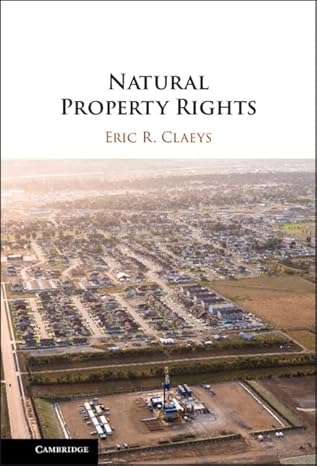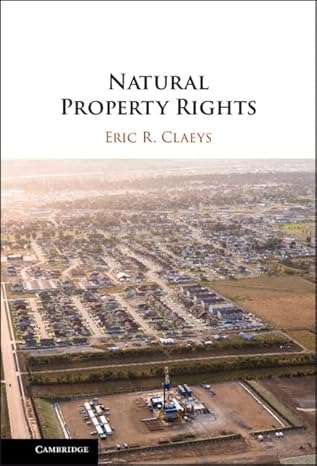
Thank you, Eugene! This week, I’m blogging about a scholarly project long in the works. Earlier this summer, I published a book, Natural Property Rights, with Cambridge University Press. If readers are interested in the book, it’s available for purchase digitally and in hardbound version, at a variety of bookstores, and it can be accessed through any library with a subscription to Cambridge UP’s digital platform. Cambridge UP will also release a (cheaper) paperback version in 2026.
In my blogging this week, I am going to try to interest lawyers, law students, and nonlawyers in Natural Property Rights. That strategy may seem unorthodox, because the book is obviously relevant to philosophers and property law scholars. But I bet there are a lot more VC readers in the groups I’m targeting than the ones I’m not. And, I’ve already made my pitch to the scholars, in an introduction and a reply to a dozen scholars in a 2023 symposium previewing Natural Property Rights in the Texas A&M Journal of Property Law.
More than that, I hope that my posts this week are timely! This week and next, U.S. law schools are opening back up for business. At some of those schools, professors will be teaching, and students will be taking, the standard first-year Property course. My posts this week will be organized around the main topics in a 1L Property course. Today, I’ll summarize Natural Property Rights‘s main themes; in each of the next four posts, I’ll cover several of the topics covered in a 1L course.
The institution of property has deep connections to natural law and natural rights. Many U.S. state constitutions take for granted that (I’m using Virginia’s constitution as an example) “the means of acquiring and possessing property” is an “inherent right.” John Locke made property the centerpiece of his natural rights theory of government. And many sources in American property law reflect those connections. I’ll say more tomorrow about Pierson v. Post, the “fox case.” In that case, the court opinion and the dissent consulted Locke and the best-known natural law treatises—by Justinian, Grotius, Pufendorf, and others—to settle what someone needs to do to capture a wild fox and appropriate it.
Given all of those connections, one might think that lawyers and scholars appreciate how natural rights and principles of natural law apply to property. Not so, for reasons I’ll explain below. Natural Property Rights tries to fill that gap. The book shows how natural rights and natural law principles supply guidance to property law, and it does so in four parts. Part I of the book introduces a mine-run theory of natural law and rights. Part II derives a specific right of property from the general theory introduced in Part I. Part III shows how that natural property right is reduced to practice, specifically in English and American property law. But property rights are protected not only in property law but also in other related fields of law. Part IV illustrates with a few examples from private law (in property torts) and public law (in doctrines about the police power, eminent domain, and regulatory takings).
What do I mean by a “mine-run theory of natural law and rights”? In normative philosophy, theories of ethics and politics are often sorted into three basic categories. Two are well-known, deontological and consequentialist. A third isn’t so well-known, and people use different labels to refer to it—”flourishing,” “perfectionism,” “virtue theory,” or “eudaimonism.” Whichever of those labels one likes, traditional natural law theories are covered by them. In such theories, people have natural capacities to live, survive, reason, and flourish. The main objects of ethics and politics are to help people exercise and hone those capacities. Theories of natural law help identify responsibilities people owe themselves and one another. Since people have objective rights to do what is objectively good, those theories also help identify distinct natural rights—like the right to life, the right to bodily security, the liberty to practice a calling, and the right to associate with others.
And, the right to property. By natural law, a property right is not a right to do with an ownable resource whatever one wants, no matter what the effects are on the right-holder or on others. Since it is natural for people to survive and to try to thrive, it’s natural as well for them to acquire things they can incorporate into the projects they develop to survive and to thrive. That capacity justifies a natural right, to acquire fair shares of ownable resources and to use them to produce morally valuable results. But the capacity also produces corresponding social responsibilities, to respect others’ equal opportunities to as they try to exercise the same right.
So the natural right to property has four elements. To be entitled to a natural right in relation to any ownable resource, an actor should (first) use the resource productively, for his or others’ moral well-being. (“Productive use” captures well what Locke meant by “labor”—or, at least, what “labor” means when justified as charitably as possible.) Since others might want to acquire and use that same resource, though, a would-be property-holder must also (and second) communicate to neighbors his claim to use the resource and enjoy the fruits of his use exclusively. Even when a proprietor acquires a natural right, the right can be challenged and limited in practice.
A necessity proviso (third) entitles people who don’t have property in a resource to commandeer it and use it for their own uses if their lives, safety, or property depend on it, as in chestnuts like Ploof v. Putnam and Vincent v. Lake Erie Transportation. More generally (and fourth), a sufficiency proviso (corresponding to Locke’s talk about “enough, and as good” for others) entitles others to use a resource already appropriated, if there aren’t enough unowned resources available for them to acquire resources for their own uses.
That natural right can guide legal reasoning in one of two ways. In a few narrow cases, officials can develop laws modeled directly on the right, as cooks follow recipes or as builders follow blueprints. More often, though, the natural right gives officials a standard to consult. When legislators set speed limits, they ask whether and how well particular limits secure rights to bodily security and travel. By analogy, when government officials evaluate property laws, they should ask whether and how well those laws secure natural property rights. More on that in my next four installments.
Earlier, I said that most contemporary lawyers and scholars do not appreciate how natural law and rights might guide property law. My proof comes from many first-year Property casebooks. Early on, students learn how people acquire private property in resources that weren’t already owned—like foxes, whales, and oil. There and then, students often get short summaries of Locke’s theory of labor.
In casebook treatments, labor seems a limited and unsatisfying basis for property. I like to describe the main criticisms as the “one-hit wonder” problem and the “one-way ratchet” problem. Labor seems to justify the acquisition (or “capture”) rules that govern disputes over wild animals like foxes or whales. But labor seems a one-hit wonder because those rules are supposedly the only property doctrines labor can justify. Labor also seems a one-way ratchet because, when it does justify property, it always justifies more property. In other words, labor seems incapable of marking off limits that common sense suggests property must possess.
Those impressions are understandable; lawyers and legal theorists like theories to apply clearly, narrowly, and deeply to the topics they are expected to cover. But law is a comprehensive institution. And for a normative theory to be satisfying in relation to a broad field like property, it should apply broadly, shallowly, and with appropriate qualifications.
I also suspect that the impressions contribute to an argument by false dichotomy. If rights- or labor-based property theories seem to apply narrowly, they can be ignored wherever they don’t apply. If they seem to justify rules that go against common sense, they can be ignored full stop. When rights- and labor-based theories are dismissed that way, it’s easier to introduce and justify the perspectives on property in vogue today—without considering serious rivals on their merits. (The theories most in vogue today include: various fairness-based or egalitarian perspectives; law and economics; and utilitarian and expertise-driven public policy approaches, like the ones familiar from the New Deal and from Supreme Court Stephen Breyer’s public writings.)
Against that backdrop, there are at least two good reasons to read Natural Property Rights. At a minimum, it helps readers evaluate rights-based theories for themselves, free from the spin they get in contemporary casebooks and booklength survey-introductions to property theory. More than that, though, the book’s theory may be more convincing than the theories in vogue now. And to explain why, I ask you to think on what I like to call the “Dennis the constitutional peasant” challenge.
In Monty Python and the Holy Grail, an uppity English peasant refuses to agree that King Arthur received a divine right to rule England when the Lady of the Lake “lobbed a scimitar” (Excalibur) to him. The scene illustrates hilariously the most basic challenge in liberal political philosophy. The rule of law is entangled with the violence inherent in a political system, and the law needs to be backed by arguments capable of legitimating the violence.
As for property, a system of property law entitles some people to exclude others from accessing and using ownable resources for their own legitimate projects. Such a system is backed by the government’s monopoly over violence, and it needs to be backed by arguments capable of justifying the use of violence to enforce the law. Natural rights can supply that sort of justification. In particular, the claim-communication requirement and the sufficiency and necessity provisos link the rights of property holders with the interests of people expected to respect those rights. I am not sure than any of the theories of property influential today addresses the constitutional peasant challenge as well as natural property rights do.
That’s enough about Natural Property Rights‘s argument and its main contributions. Tomorrow, I hope to post on the topics that take up the first three or four weeks of a standard Property course. So tomorrow, then, more on foxes, whale, oil, coal, and Johnson v. M’Intosh.
The post Natural Property Rights: A Volokh Conspiracy Preview appeared first on Reason.com.






